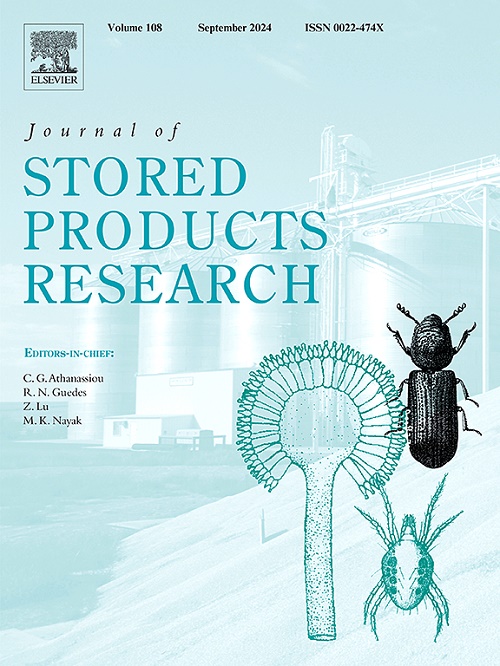Application of reuterin-containing edible coating to inhibit the growth of aflatoxigenic Aspergillus flavus on nutmeg
IF 2.7
2区 农林科学
Q1 ENTOMOLOGY
引用次数: 0
Abstract
Contamination of Aspergillus flavus (A. flavus) and aflatoxin in nutmeg remains problematic due to the poor postharvest handling practices and the climate, which is favorable for fungal growth in Indonesia. Using the natural antifungal agents can be an alternative measure to control the aflatoxin-producing fungal growth. This current study aimed to evaluate the efficacy of reuterin in inhibiting aflatoxigenic A. flavus growth on the nutmeg during storage. Reuterin at concentrations of 4, 6, 8, and 10 × MIC (1 MIC = 6 mM) was incorporated into a carboxymethyl cellulose (CMC)-based edible coating to coat the surface of nutmeg spiked with A. flavus conidia (2.5 × 102 CFU/g). Results showed that reuterin effectively extended the lag phase of A. flavus growth on the coated nutmeg and disrupted the hyphal development and conidiation. At a minimum concentration of 48 mM (equal to 3.63 mg/mL coating solution or 630 mg/kg nutmeg), reuterin inhibited completely the growth of A. flavus on the nutmeg stored at an RH of 97% and a temperature of 30 °C for 30 days. This study confirmed that the application of reuterin incorporated into a CMC-based edible coating was an effective measure for inhibiting aflatoxigenic A. flavus growth on the nutmeg during storage.
求助全文
约1分钟内获得全文
求助全文
来源期刊
CiteScore
5.70
自引率
18.50%
发文量
112
审稿时长
45 days
期刊介绍:
The Journal of Stored Products Research provides an international medium for the publication of both reviews and original results from laboratory and field studies on the preservation and safety of stored products, notably food stocks, covering storage-related problems from the producer through the supply chain to the consumer. Stored products are characterised by having relatively low moisture content and include raw and semi-processed foods, animal feedstuffs, and a range of other durable items, including materials such as clothing or museum artefacts.

 求助内容:
求助内容: 应助结果提醒方式:
应助结果提醒方式:


